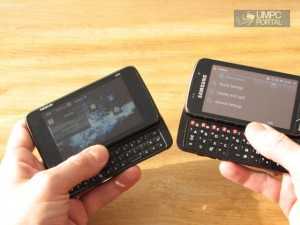There’s some nice chit-chat going on about the camera on the N900 right now. Ari Jaaksi highlighted the rather stunning set of photos appearing on Flickr which has prompted a lot of people to go ‘wow!’
I’m holding back on recommending the N900 as a good cameraphone choice based on issues I’m seeing outside the realm of pure image quality.
A smartphone is, for most people, a snapshot camera. It’s there to take photos of events as they happen. Family, friends etc. The most important thing is that it produces the best snapshots which means being able to do more than just get a technically correct white balance or depth of field.
I tested the N82 camera against the Omnia Pro recently and here are the criteria I used to asses it. If you’re looking for a cameraphone or reviewing a cameraphone, think about the following:
- General image quality (lens quality and sensor quality more important than megapixels)
- Low-light photography (without flash) A sensitive sensor means not having to use flash. A natural lighting wash is often better than a pinpoint flash. It also means that the camera can choose higher shutter speeds and therefore produce sharper images.
- Flash. For very low light images, flash is required. Xenon flash make a great choice not just for its power but for it’s short duration that can ‘freeze’ images. A long duration LED flash can result in blurry images if the subject is moving.
- Preview screen (both indoor and outdoor) I make a lot o mistakes on my N82 purely because I can’t see what is in focus and what isn’t. A big, high-brightness screen is a superb way to secure a better ‘hit’ rate.
- Access to controls. Touchscreen devices can make accessing camera options easy. CHeck out how many presses you need to make to turn the flash from ‘auto’ to ‘red eye.’ for example.
- Type of controls. If you want to get creative you’ll need access to focus controls, iso, apperture, shutter speed and white balance but there are some other features that are good. How about automatically taking 6 shots at a time? Or being able to detect movemement. Some of these features are gimmicks, some are useful.
- Pre-focus. Make sure that the camera is able to pre-focus by pushing the shutter release button down half-way. If you’re able to prepare for a shot like this, the duration between pressing the shutter release button and the camera taking the image can drop dramatically. A near instantaneous press/capture is obviously ideal.
- Speed to remove device from pocket and start camera. THere’s nothing worse than waiting for a device to come out of standby and waiting for the camera application to start. Having a shutter cover rather than a case saves time. Having a quick unlock feature saves time. Fast software saves time.
- Quick review. Being able to see the photo you’ve taken is critical. Often the shutter sound does not correspond exactly to the time the image was taken. If the preview takes 2 or 3 seconds to appear it’s annoying for both you and your subject.
- Transfer of photos (online, usb bluetooth, tv) Think about where you need to send your photos. Do you use flickr. If so, think about a phone that uses 3G with a fast upload speed (HSUPA or HSPA for example.) Make sure the transfer process can be run in the background. Also think about USB transfer speed.
- Lens cover. The value of a lens cover can not be understated. A greasy, scratched, dusty lens is the last thing you want.
- Geotagging. Geotagging isnt just for fun, it helps you to organise your photos based on places. A fast GPS lock or use of network location services can help.
- Overall size of device. If it’s too big you might put it in your bag.
- Price. Clearly price is a major consideration.
- Apps. Think about third party software. The iPhone has a number of good camera applications that can be used for different scenarios.
- Future. Phones can often get better over time. Firmware gets improved and a phone that may have been slow on first release might get upgraded. A phone older than 18 months is not likely to get regular firmware updates.
- Build quality. A cameraphone WILL take a beating. Think about moving parts, exposed ports and moving parts.
My experience with the N900 so far is that the lens and sensor quality is superb. The device has a lens cover and is relatively small. The problem right now is the firmware because it’s way too slow. Fortunately, the N900 will get firmware updates so if the camera is critical for you, it would make sense to wait until the first firmware update until you make a decision on it.
You’ll fnd some more thoughts and some sample images in this comparision between the N900 and the Omnia Pro B7610












Mind changing “asses” to “assess” ? Please .
Many thanks!